ESOFT Metro College: Information Needs and System Suitability Report
VerifiedAdded on 2023/01/18
|23
|5547
|79
Report
AI Summary
This report provides a detailed analysis of ESOFT Metro College, a higher education institute in Sri Lanka, focusing on its functional areas, information needs, and the suitability of various information systems. The report begins with an executive summary and a table of contents, followed by an overview of ESOFT's mission, vision, values, and courses. It then identifies and evaluates the information needs of the organization's functional areas, including senior management, human resources, and marketing. The report examines the use of different information systems, such as Management Information Systems (MIS), Executive Information Systems (EIS), Decision Support Systems (DSS), Expert Systems, and Transaction Processing Systems (TPS), within these functional areas. It also compares various information systems and investigates current trends. Finally, the report identifies major issues within the organization and proposes solutions using information systems to generate accurate and useful management information. The report provides a comprehensive understanding of ESOFT's operational and informational dynamics, highlighting the importance of effective information systems in supporting its strategic goals.

Executive Summary
The selection of ESOFT Metro College was a choice of mine. An introduction of the
company is clearly mentioned about their companies’ organizational details.
According to the information studied, the current system of the organization has been
understood with its issues related to information systems and have clearly mentioned a detail
description about the use of information systems and different types of systems which are
currently used in the industry.
.
P.N.Lakshini, HND batch
1 | P a g e
The selection of ESOFT Metro College was a choice of mine. An introduction of the
company is clearly mentioned about their companies’ organizational details.
According to the information studied, the current system of the organization has been
understood with its issues related to information systems and have clearly mentioned a detail
description about the use of information systems and different types of systems which are
currently used in the industry.
.
P.N.Lakshini, HND batch
1 | P a g e
Paraphrase This Document
Need a fresh take? Get an instant paraphrase of this document with our AI Paraphraser
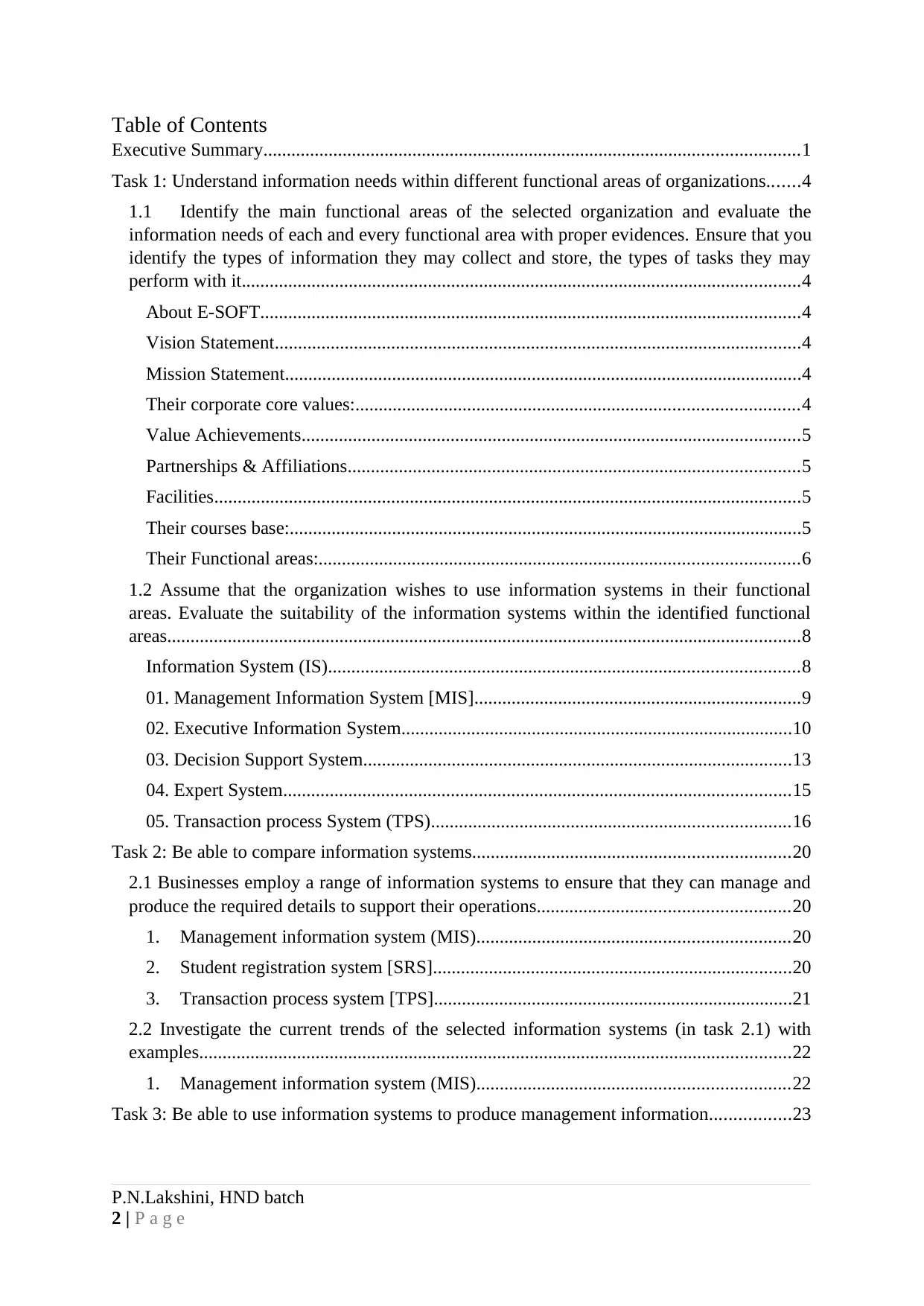
Table of Contents
Executive Summary...................................................................................................................1
Task 1: Understand information needs within different functional areas of organizations.......4
1.1 Identify the main functional areas of the selected organization and evaluate the
information needs of each and every functional area with proper evidences. Ensure that you
identify the types of information they may collect and store, the types of tasks they may
perform with it........................................................................................................................4
About E-SOFT....................................................................................................................4
Vision Statement.................................................................................................................4
Mission Statement...............................................................................................................4
Their corporate core values:...............................................................................................4
Value Achievements...........................................................................................................5
Partnerships & Affiliations.................................................................................................5
Facilities..............................................................................................................................5
Their courses base:..............................................................................................................5
Their Functional areas:.......................................................................................................6
1.2 Assume that the organization wishes to use information systems in their functional
areas. Evaluate the suitability of the information systems within the identified functional
areas........................................................................................................................................8
Information System (IS).....................................................................................................8
01. Management Information System [MIS]......................................................................9
02. Executive Information System....................................................................................10
03. Decision Support System............................................................................................13
04. Expert System.............................................................................................................15
05. Transaction process System (TPS).............................................................................16
Task 2: Be able to compare information systems....................................................................20
2.1 Businesses employ a range of information systems to ensure that they can manage and
produce the required details to support their operations......................................................20
1. Management information system (MIS)...................................................................20
2. Student registration system [SRS].............................................................................20
3. Transaction process system [TPS].............................................................................21
2.2 Investigate the current trends of the selected information systems (in task 2.1) with
examples...............................................................................................................................22
1. Management information system (MIS)...................................................................22
Task 3: Be able to use information systems to produce management information.................23
P.N.Lakshini, HND batch
2 | P a g e
Executive Summary...................................................................................................................1
Task 1: Understand information needs within different functional areas of organizations.......4
1.1 Identify the main functional areas of the selected organization and evaluate the
information needs of each and every functional area with proper evidences. Ensure that you
identify the types of information they may collect and store, the types of tasks they may
perform with it........................................................................................................................4
About E-SOFT....................................................................................................................4
Vision Statement.................................................................................................................4
Mission Statement...............................................................................................................4
Their corporate core values:...............................................................................................4
Value Achievements...........................................................................................................5
Partnerships & Affiliations.................................................................................................5
Facilities..............................................................................................................................5
Their courses base:..............................................................................................................5
Their Functional areas:.......................................................................................................6
1.2 Assume that the organization wishes to use information systems in their functional
areas. Evaluate the suitability of the information systems within the identified functional
areas........................................................................................................................................8
Information System (IS).....................................................................................................8
01. Management Information System [MIS]......................................................................9
02. Executive Information System....................................................................................10
03. Decision Support System............................................................................................13
04. Expert System.............................................................................................................15
05. Transaction process System (TPS).............................................................................16
Task 2: Be able to compare information systems....................................................................20
2.1 Businesses employ a range of information systems to ensure that they can manage and
produce the required details to support their operations......................................................20
1. Management information system (MIS)...................................................................20
2. Student registration system [SRS].............................................................................20
3. Transaction process system [TPS].............................................................................21
2.2 Investigate the current trends of the selected information systems (in task 2.1) with
examples...............................................................................................................................22
1. Management information system (MIS)...................................................................22
Task 3: Be able to use information systems to produce management information.................23
P.N.Lakshini, HND batch
2 | P a g e
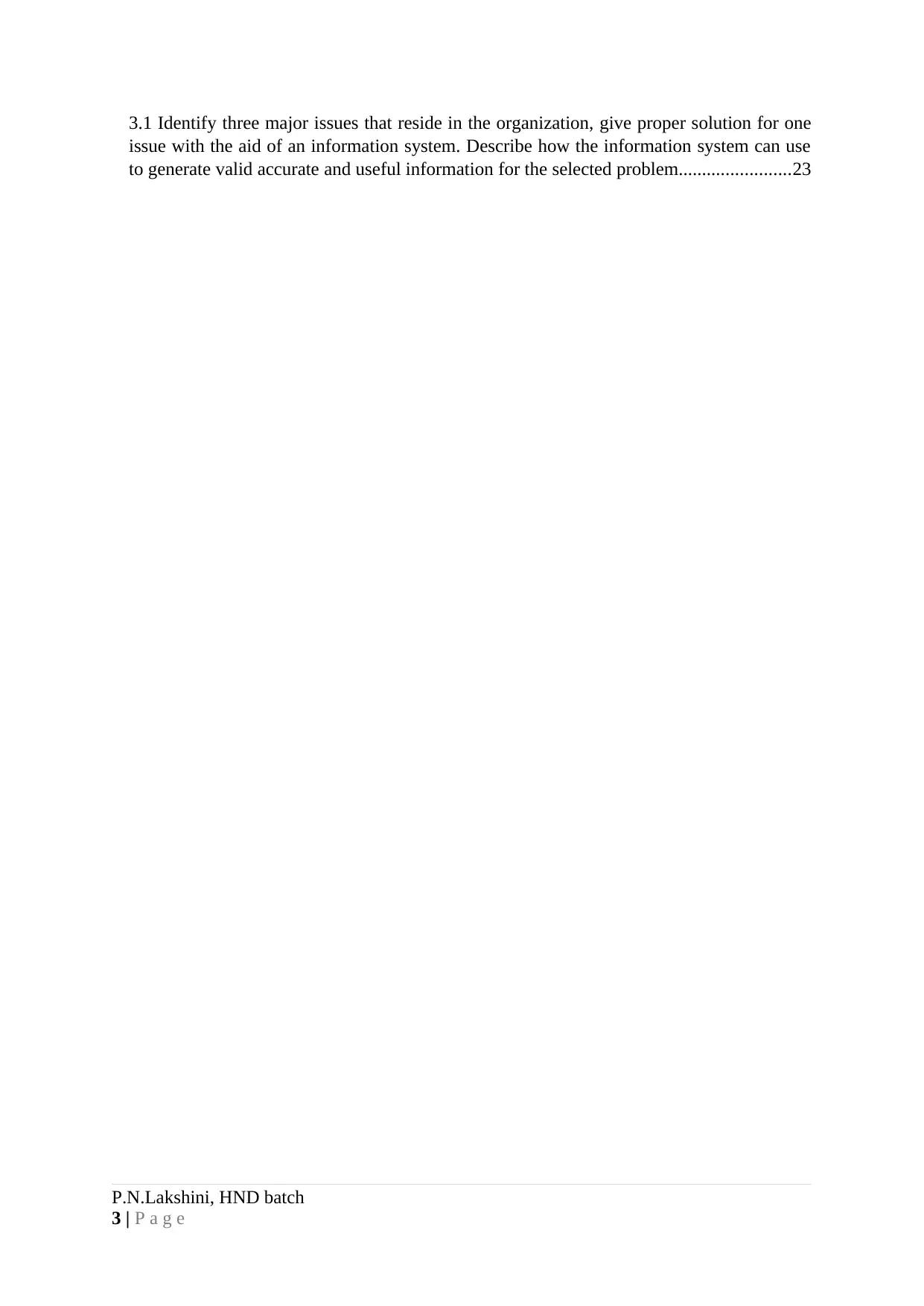
3.1 Identify three major issues that reside in the organization, give proper solution for one
issue with the aid of an information system. Describe how the information system can use
to generate valid accurate and useful information for the selected problem........................23
P.N.Lakshini, HND batch
3 | P a g e
issue with the aid of an information system. Describe how the information system can use
to generate valid accurate and useful information for the selected problem........................23
P.N.Lakshini, HND batch
3 | P a g e
⊘ This is a preview!⊘
Do you want full access?
Subscribe today to unlock all pages.

Trusted by 1+ million students worldwide
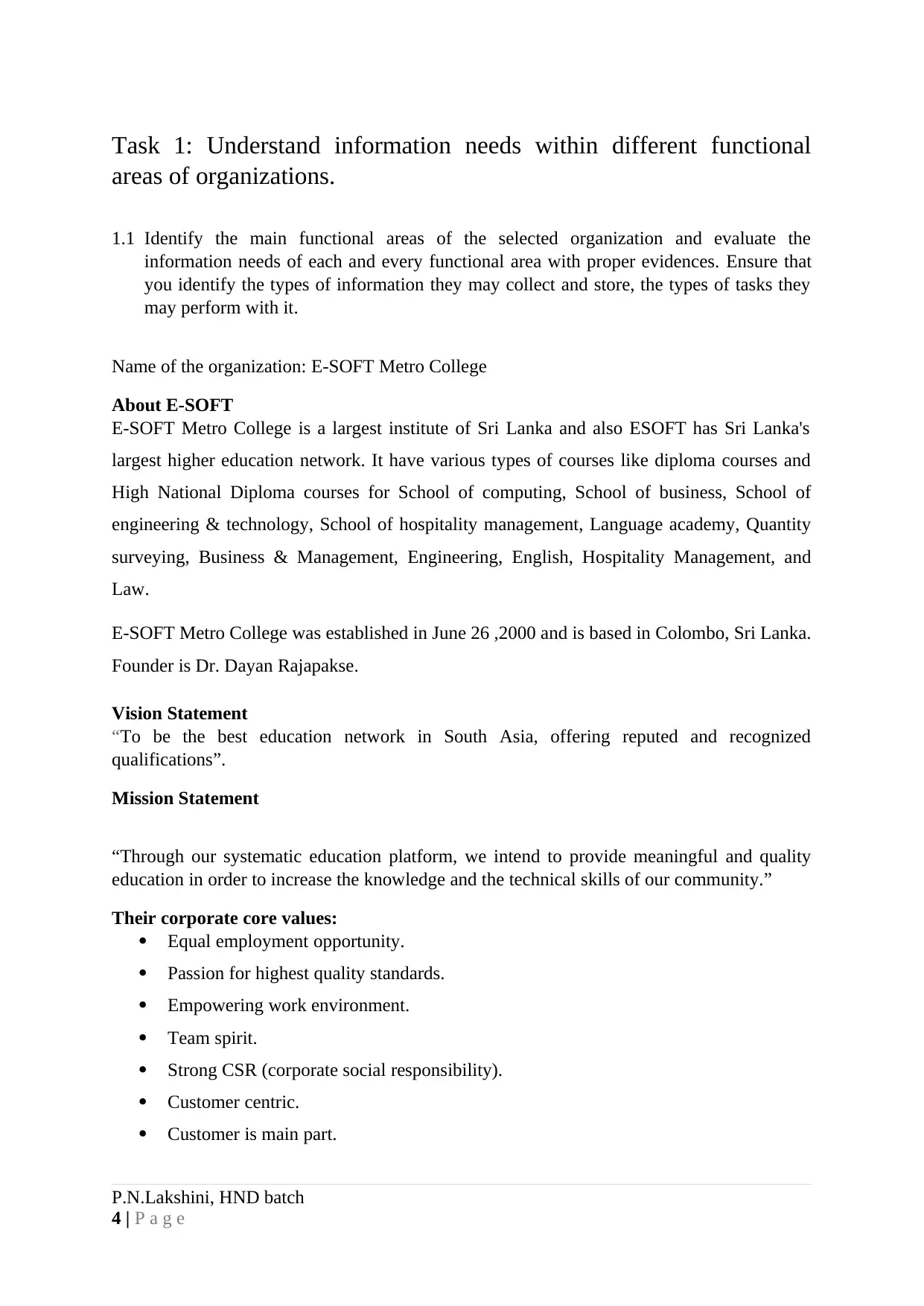
Task 1: Understand information needs within different functional
areas of organizations.
1.1 Identify the main functional areas of the selected organization and evaluate the
information needs of each and every functional area with proper evidences. Ensure that
you identify the types of information they may collect and store, the types of tasks they
may perform with it.
Name of the organization: E-SOFT Metro College
About E-SOFT
E-SOFT Metro College is a largest institute of Sri Lanka and also ESOFT has Sri Lanka's
largest higher education network. It have various types of courses like diploma courses and
High National Diploma courses for School of computing, School of business, School of
engineering & technology, School of hospitality management, Language academy, Quantity
surveying, Business & Management, Engineering, English, Hospitality Management, and
Law.
E-SOFT Metro College was established in June 26 ,2000 and is based in Colombo, Sri Lanka.
Founder is Dr. Dayan Rajapakse.
Vision Statement
“To be the best education network in South Asia, offering reputed and recognized
qualifications”.
Mission Statement
“Through our systematic education platform, we intend to provide meaningful and quality
education in order to increase the knowledge and the technical skills of our community.”
Their corporate core values:
Equal employment opportunity.
Passion for highest quality standards.
Empowering work environment.
Team spirit.
Strong CSR (corporate social responsibility).
Customer centric.
Customer is main part.
P.N.Lakshini, HND batch
4 | P a g e
areas of organizations.
1.1 Identify the main functional areas of the selected organization and evaluate the
information needs of each and every functional area with proper evidences. Ensure that
you identify the types of information they may collect and store, the types of tasks they
may perform with it.
Name of the organization: E-SOFT Metro College
About E-SOFT
E-SOFT Metro College is a largest institute of Sri Lanka and also ESOFT has Sri Lanka's
largest higher education network. It have various types of courses like diploma courses and
High National Diploma courses for School of computing, School of business, School of
engineering & technology, School of hospitality management, Language academy, Quantity
surveying, Business & Management, Engineering, English, Hospitality Management, and
Law.
E-SOFT Metro College was established in June 26 ,2000 and is based in Colombo, Sri Lanka.
Founder is Dr. Dayan Rajapakse.
Vision Statement
“To be the best education network in South Asia, offering reputed and recognized
qualifications”.
Mission Statement
“Through our systematic education platform, we intend to provide meaningful and quality
education in order to increase the knowledge and the technical skills of our community.”
Their corporate core values:
Equal employment opportunity.
Passion for highest quality standards.
Empowering work environment.
Team spirit.
Strong CSR (corporate social responsibility).
Customer centric.
Customer is main part.
P.N.Lakshini, HND batch
4 | P a g e
Paraphrase This Document
Need a fresh take? Get an instant paraphrase of this document with our AI Paraphraser
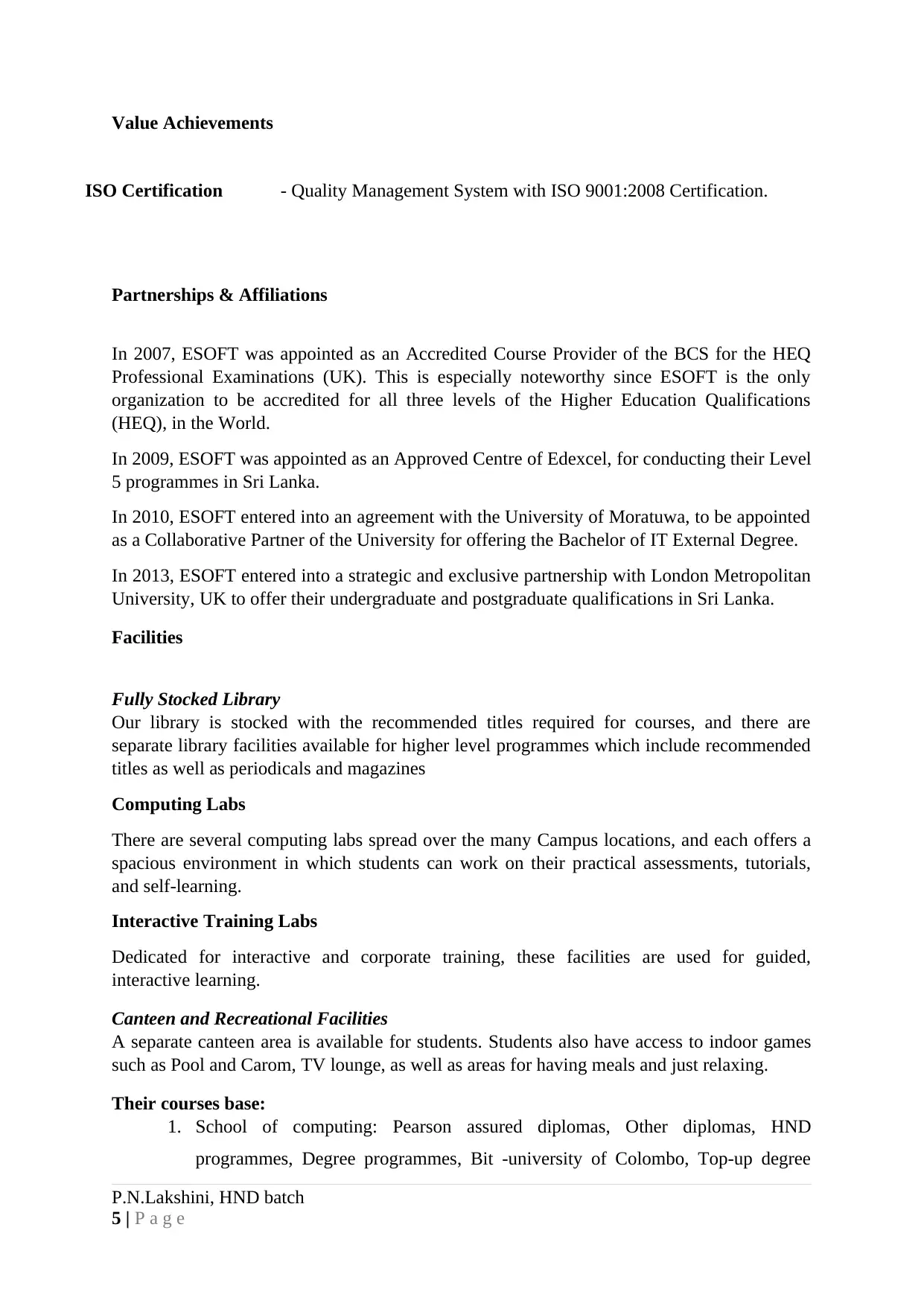
Value Achievements
ISO Certification - Quality Management System with ISO 9001:2008 Certification.
Partnerships & Affiliations
In 2007, ESOFT was appointed as an Accredited Course Provider of the BCS for the HEQ
Professional Examinations (UK). This is especially noteworthy since ESOFT is the only
organization to be accredited for all three levels of the Higher Education Qualifications
(HEQ), in the World.
In 2009, ESOFT was appointed as an Approved Centre of Edexcel, for conducting their Level
5 programmes in Sri Lanka.
In 2010, ESOFT entered into an agreement with the University of Moratuwa, to be appointed
as a Collaborative Partner of the University for offering the Bachelor of IT External Degree.
In 2013, ESOFT entered into a strategic and exclusive partnership with London Metropolitan
University, UK to offer their undergraduate and postgraduate qualifications in Sri Lanka.
Facilities
Fully Stocked Library
Our library is stocked with the recommended titles required for courses, and there are
separate library facilities available for higher level programmes which include recommended
titles as well as periodicals and magazines
Computing Labs
There are several computing labs spread over the many Campus locations, and each offers a
spacious environment in which students can work on their practical assessments, tutorials,
and self-learning.
Interactive Training Labs
Dedicated for interactive and corporate training, these facilities are used for guided,
interactive learning.
Canteen and Recreational Facilities
A separate canteen area is available for students. Students also have access to indoor games
such as Pool and Carom, TV lounge, as well as areas for having meals and just relaxing.
Their courses base:
1. School of computing: Pearson assured diplomas, Other diplomas, HND
programmes, Degree programmes, Bit -university of Colombo, Top-up degree
P.N.Lakshini, HND batch
5 | P a g e
ISO Certification - Quality Management System with ISO 9001:2008 Certification.
Partnerships & Affiliations
In 2007, ESOFT was appointed as an Accredited Course Provider of the BCS for the HEQ
Professional Examinations (UK). This is especially noteworthy since ESOFT is the only
organization to be accredited for all three levels of the Higher Education Qualifications
(HEQ), in the World.
In 2009, ESOFT was appointed as an Approved Centre of Edexcel, for conducting their Level
5 programmes in Sri Lanka.
In 2010, ESOFT entered into an agreement with the University of Moratuwa, to be appointed
as a Collaborative Partner of the University for offering the Bachelor of IT External Degree.
In 2013, ESOFT entered into a strategic and exclusive partnership with London Metropolitan
University, UK to offer their undergraduate and postgraduate qualifications in Sri Lanka.
Facilities
Fully Stocked Library
Our library is stocked with the recommended titles required for courses, and there are
separate library facilities available for higher level programmes which include recommended
titles as well as periodicals and magazines
Computing Labs
There are several computing labs spread over the many Campus locations, and each offers a
spacious environment in which students can work on their practical assessments, tutorials,
and self-learning.
Interactive Training Labs
Dedicated for interactive and corporate training, these facilities are used for guided,
interactive learning.
Canteen and Recreational Facilities
A separate canteen area is available for students. Students also have access to indoor games
such as Pool and Carom, TV lounge, as well as areas for having meals and just relaxing.
Their courses base:
1. School of computing: Pearson assured diplomas, Other diplomas, HND
programmes, Degree programmes, Bit -university of Colombo, Top-up degree
P.N.Lakshini, HND batch
5 | P a g e
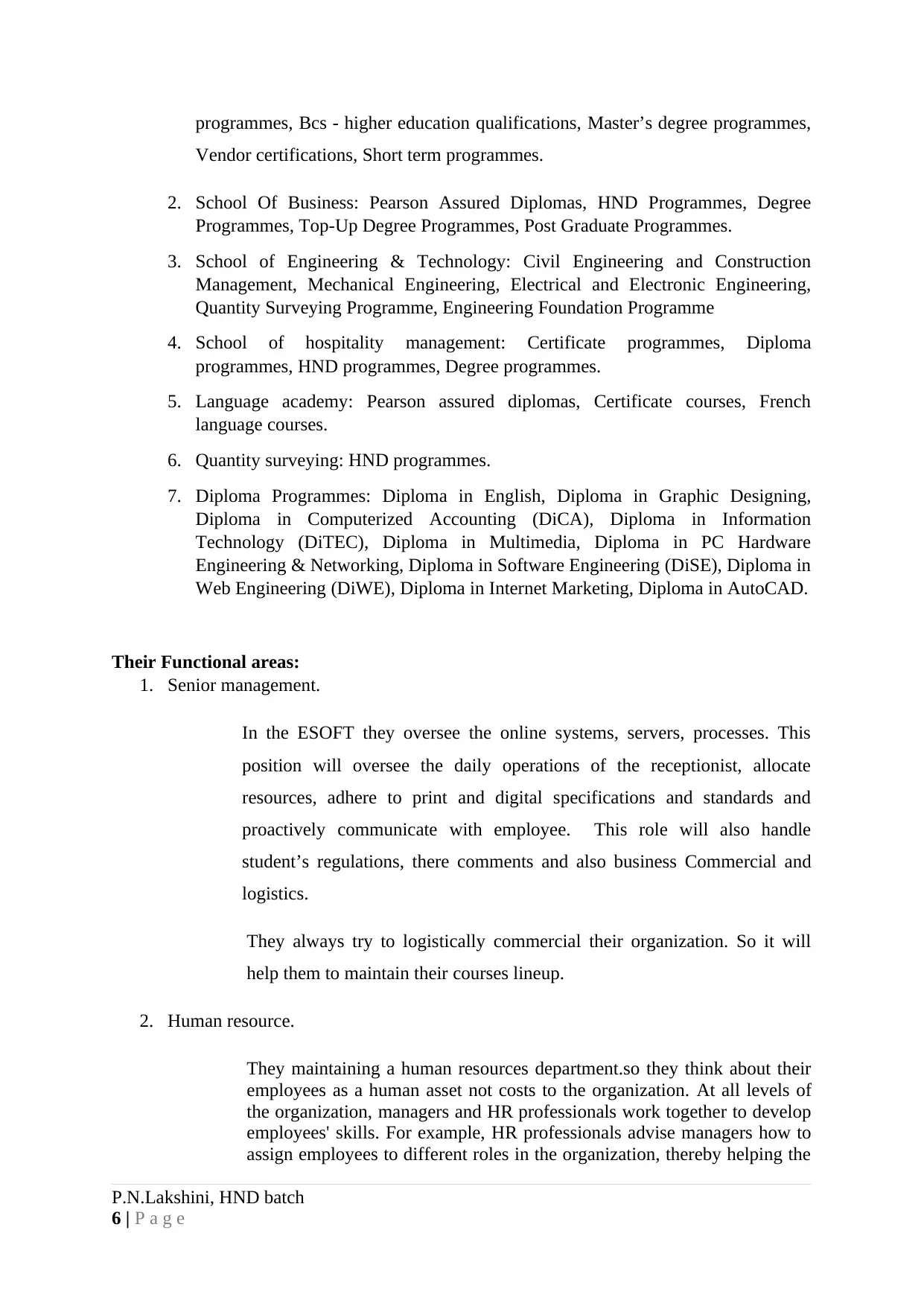
programmes, Bcs - higher education qualifications, Master’s degree programmes,
Vendor certifications, Short term programmes.
2. School Of Business: Pearson Assured Diplomas, HND Programmes, Degree
Programmes, Top-Up Degree Programmes, Post Graduate Programmes.
3. School of Engineering & Technology: Civil Engineering and Construction
Management, Mechanical Engineering, Electrical and Electronic Engineering,
Quantity Surveying Programme, Engineering Foundation Programme
4. School of hospitality management: Certificate programmes, Diploma
programmes, HND programmes, Degree programmes.
5. Language academy: Pearson assured diplomas, Certificate courses, French
language courses.
6. Quantity surveying: HND programmes.
7. Diploma Programmes: Diploma in English, Diploma in Graphic Designing,
Diploma in Computerized Accounting (DiCA), Diploma in Information
Technology (DiTEC), Diploma in Multimedia, Diploma in PC Hardware
Engineering & Networking, Diploma in Software Engineering (DiSE), Diploma in
Web Engineering (DiWE), Diploma in Internet Marketing, Diploma in AutoCAD.
Their Functional areas:
1. Senior management.
In the ESOFT they oversee the online systems, servers, processes. This
position will oversee the daily operations of the receptionist, allocate
resources, adhere to print and digital specifications and standards and
proactively communicate with employee. This role will also handle
student’s regulations, there comments and also business Commercial and
logistics.
They always try to logistically commercial their organization. So it will
help them to maintain their courses lineup.
2. Human resource.
They maintaining a human resources department.so they think about their
employees as a human asset not costs to the organization. At all levels of
the organization, managers and HR professionals work together to develop
employees' skills. For example, HR professionals advise managers how to
assign employees to different roles in the organization, thereby helping the
P.N.Lakshini, HND batch
6 | P a g e
Vendor certifications, Short term programmes.
2. School Of Business: Pearson Assured Diplomas, HND Programmes, Degree
Programmes, Top-Up Degree Programmes, Post Graduate Programmes.
3. School of Engineering & Technology: Civil Engineering and Construction
Management, Mechanical Engineering, Electrical and Electronic Engineering,
Quantity Surveying Programme, Engineering Foundation Programme
4. School of hospitality management: Certificate programmes, Diploma
programmes, HND programmes, Degree programmes.
5. Language academy: Pearson assured diplomas, Certificate courses, French
language courses.
6. Quantity surveying: HND programmes.
7. Diploma Programmes: Diploma in English, Diploma in Graphic Designing,
Diploma in Computerized Accounting (DiCA), Diploma in Information
Technology (DiTEC), Diploma in Multimedia, Diploma in PC Hardware
Engineering & Networking, Diploma in Software Engineering (DiSE), Diploma in
Web Engineering (DiWE), Diploma in Internet Marketing, Diploma in AutoCAD.
Their Functional areas:
1. Senior management.
In the ESOFT they oversee the online systems, servers, processes. This
position will oversee the daily operations of the receptionist, allocate
resources, adhere to print and digital specifications and standards and
proactively communicate with employee. This role will also handle
student’s regulations, there comments and also business Commercial and
logistics.
They always try to logistically commercial their organization. So it will
help them to maintain their courses lineup.
2. Human resource.
They maintaining a human resources department.so they think about their
employees as a human asset not costs to the organization. At all levels of
the organization, managers and HR professionals work together to develop
employees' skills. For example, HR professionals advise managers how to
assign employees to different roles in the organization, thereby helping the
P.N.Lakshini, HND batch
6 | P a g e
⊘ This is a preview!⊘
Do you want full access?
Subscribe today to unlock all pages.

Trusted by 1+ million students worldwide
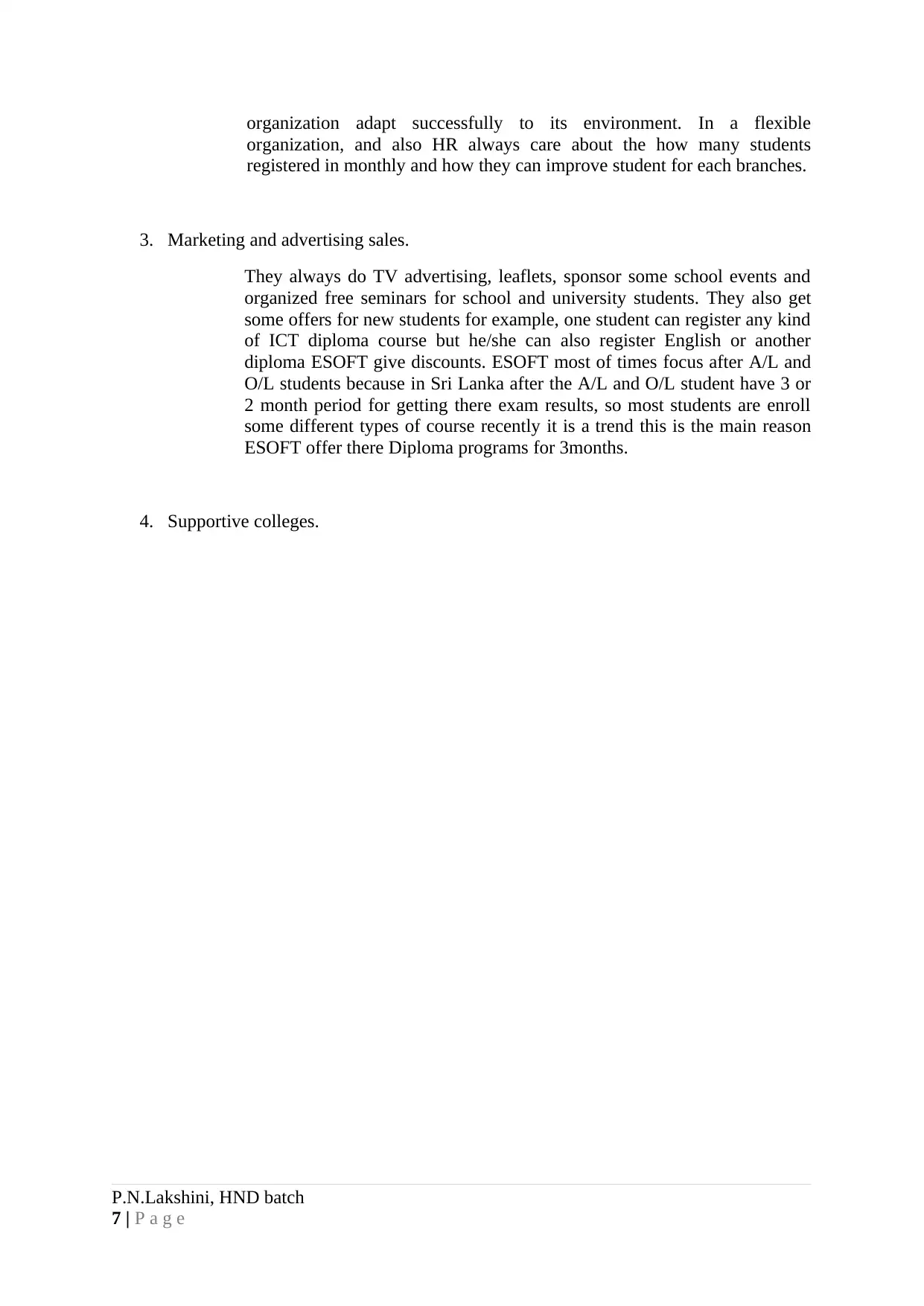
organization adapt successfully to its environment. In a flexible
organization, and also HR always care about the how many students
registered in monthly and how they can improve student for each branches.
3. Marketing and advertising sales.
They always do TV advertising, leaflets, sponsor some school events and
organized free seminars for school and university students. They also get
some offers for new students for example, one student can register any kind
of ICT diploma course but he/she can also register English or another
diploma ESOFT give discounts. ESOFT most of times focus after A/L and
O/L students because in Sri Lanka after the A/L and O/L student have 3 or
2 month period for getting there exam results, so most students are enroll
some different types of course recently it is a trend this is the main reason
ESOFT offer there Diploma programs for 3months.
4. Supportive colleges.
P.N.Lakshini, HND batch
7 | P a g e
organization, and also HR always care about the how many students
registered in monthly and how they can improve student for each branches.
3. Marketing and advertising sales.
They always do TV advertising, leaflets, sponsor some school events and
organized free seminars for school and university students. They also get
some offers for new students for example, one student can register any kind
of ICT diploma course but he/she can also register English or another
diploma ESOFT give discounts. ESOFT most of times focus after A/L and
O/L students because in Sri Lanka after the A/L and O/L student have 3 or
2 month period for getting there exam results, so most students are enroll
some different types of course recently it is a trend this is the main reason
ESOFT offer there Diploma programs for 3months.
4. Supportive colleges.
P.N.Lakshini, HND batch
7 | P a g e
Paraphrase This Document
Need a fresh take? Get an instant paraphrase of this document with our AI Paraphraser

IS
Operations
support
systems
TPS
Process
control
systems
Enterprise
collaboration
systems
Management
support
systems
MIS DSS EIS
1.2 Assume that the organization wishes to use information systems in their functional
areas. Evaluate the suitability of the information systems within the identified
functional areas.
Information System (IS)
An information System (IS)Refer to collection of multiple pieces of equipment involved
in the Dissemination of information Hardware, software, computer system connection and
information, system users, and the system housing are all the parts of IS.
Let’s identified these components,
Hard Ware
Software
Data
Procedures
People
There are several types of information systems, including the following common types:
Figure 1.1- Several types of information systems
P.N.Lakshini, HND batch
8 | P a g e
Operations
support
systems
TPS
Process
control
systems
Enterprise
collaboration
systems
Management
support
systems
MIS DSS EIS
1.2 Assume that the organization wishes to use information systems in their functional
areas. Evaluate the suitability of the information systems within the identified
functional areas.
Information System (IS)
An information System (IS)Refer to collection of multiple pieces of equipment involved
in the Dissemination of information Hardware, software, computer system connection and
information, system users, and the system housing are all the parts of IS.
Let’s identified these components,
Hard Ware
Software
Data
Procedures
People
There are several types of information systems, including the following common types:
Figure 1.1- Several types of information systems
P.N.Lakshini, HND batch
8 | P a g e
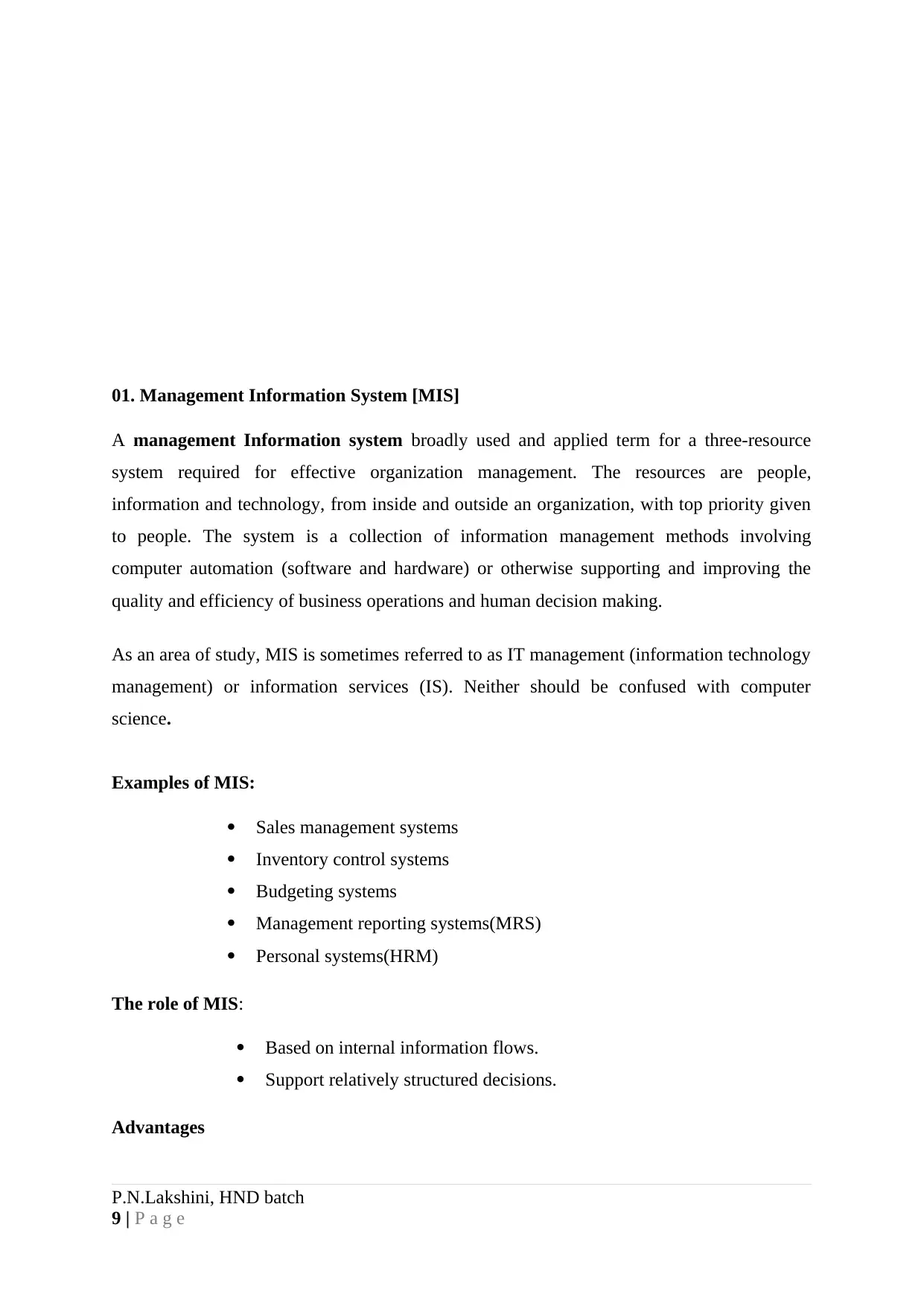
01. Management Information System [MIS]
A management Information system broadly used and applied term for a three-resource
system required for effective organization management. The resources are people,
information and technology, from inside and outside an organization, with top priority given
to people. The system is a collection of information management methods involving
computer automation (software and hardware) or otherwise supporting and improving the
quality and efficiency of business operations and human decision making.
As an area of study, MIS is sometimes referred to as IT management (information technology
management) or information services (IS). Neither should be confused with computer
science.
Examples of MIS:
Sales management systems
Inventory control systems
Budgeting systems
Management reporting systems(MRS)
Personal systems(HRM)
The role of MIS:
Based on internal information flows.
Support relatively structured decisions.
Advantages
P.N.Lakshini, HND batch
9 | P a g e
A management Information system broadly used and applied term for a three-resource
system required for effective organization management. The resources are people,
information and technology, from inside and outside an organization, with top priority given
to people. The system is a collection of information management methods involving
computer automation (software and hardware) or otherwise supporting and improving the
quality and efficiency of business operations and human decision making.
As an area of study, MIS is sometimes referred to as IT management (information technology
management) or information services (IS). Neither should be confused with computer
science.
Examples of MIS:
Sales management systems
Inventory control systems
Budgeting systems
Management reporting systems(MRS)
Personal systems(HRM)
The role of MIS:
Based on internal information flows.
Support relatively structured decisions.
Advantages
P.N.Lakshini, HND batch
9 | P a g e
⊘ This is a preview!⊘
Do you want full access?
Subscribe today to unlock all pages.

Trusted by 1+ million students worldwide
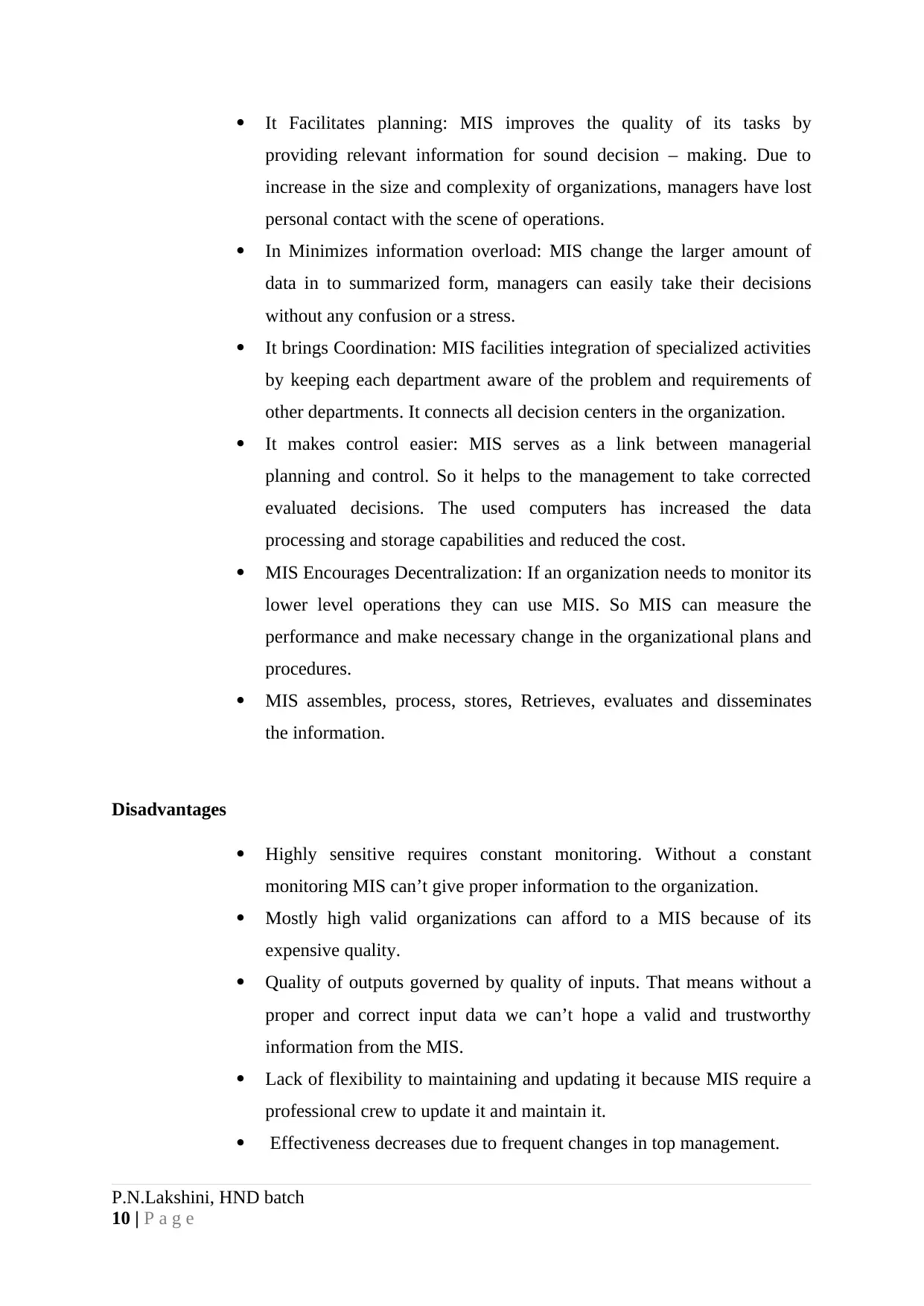
It Facilitates planning: MIS improves the quality of its tasks by
providing relevant information for sound decision – making. Due to
increase in the size and complexity of organizations, managers have lost
personal contact with the scene of operations.
In Minimizes information overload: MIS change the larger amount of
data in to summarized form, managers can easily take their decisions
without any confusion or a stress.
It brings Coordination: MIS facilities integration of specialized activities
by keeping each department aware of the problem and requirements of
other departments. It connects all decision centers in the organization.
It makes control easier: MIS serves as a link between managerial
planning and control. So it helps to the management to take corrected
evaluated decisions. The used computers has increased the data
processing and storage capabilities and reduced the cost.
MIS Encourages Decentralization: If an organization needs to monitor its
lower level operations they can use MIS. So MIS can measure the
performance and make necessary change in the organizational plans and
procedures.
MIS assembles, process, stores, Retrieves, evaluates and disseminates
the information.
Disadvantages
Highly sensitive requires constant monitoring. Without a constant
monitoring MIS can’t give proper information to the organization.
Mostly high valid organizations can afford to a MIS because of its
expensive quality.
Quality of outputs governed by quality of inputs. That means without a
proper and correct input data we can’t hope a valid and trustworthy
information from the MIS.
Lack of flexibility to maintaining and updating it because MIS require a
professional crew to update it and maintain it.
Effectiveness decreases due to frequent changes in top management.
P.N.Lakshini, HND batch
10 | P a g e
providing relevant information for sound decision – making. Due to
increase in the size and complexity of organizations, managers have lost
personal contact with the scene of operations.
In Minimizes information overload: MIS change the larger amount of
data in to summarized form, managers can easily take their decisions
without any confusion or a stress.
It brings Coordination: MIS facilities integration of specialized activities
by keeping each department aware of the problem and requirements of
other departments. It connects all decision centers in the organization.
It makes control easier: MIS serves as a link between managerial
planning and control. So it helps to the management to take corrected
evaluated decisions. The used computers has increased the data
processing and storage capabilities and reduced the cost.
MIS Encourages Decentralization: If an organization needs to monitor its
lower level operations they can use MIS. So MIS can measure the
performance and make necessary change in the organizational plans and
procedures.
MIS assembles, process, stores, Retrieves, evaluates and disseminates
the information.
Disadvantages
Highly sensitive requires constant monitoring. Without a constant
monitoring MIS can’t give proper information to the organization.
Mostly high valid organizations can afford to a MIS because of its
expensive quality.
Quality of outputs governed by quality of inputs. That means without a
proper and correct input data we can’t hope a valid and trustworthy
information from the MIS.
Lack of flexibility to maintaining and updating it because MIS require a
professional crew to update it and maintain it.
Effectiveness decreases due to frequent changes in top management.
P.N.Lakshini, HND batch
10 | P a g e
Paraphrase This Document
Need a fresh take? Get an instant paraphrase of this document with our AI Paraphraser
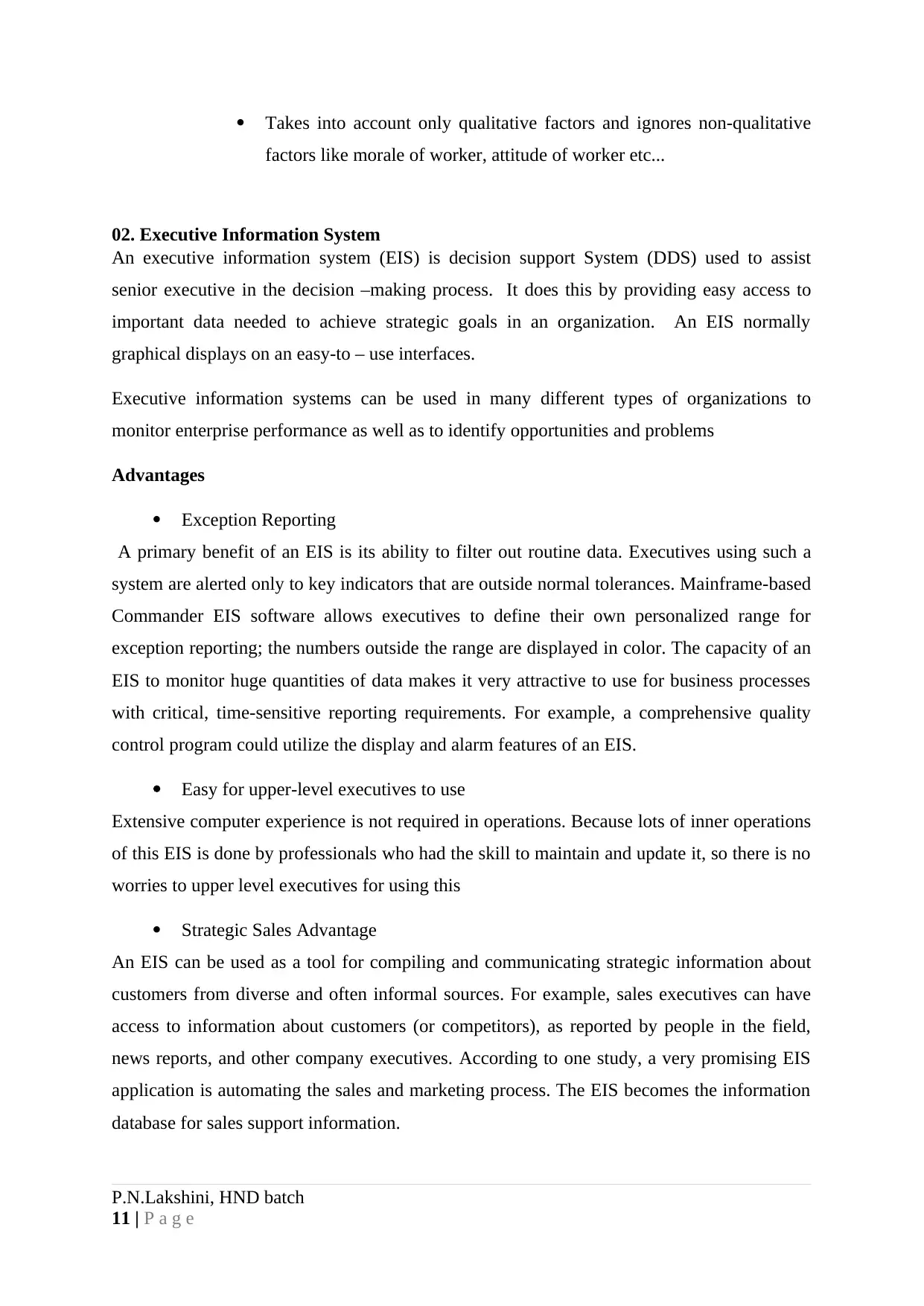
Takes into account only qualitative factors and ignores non-qualitative
factors like morale of worker, attitude of worker etc...
02. Executive Information System
An executive information system (EIS) is decision support System (DDS) used to assist
senior executive in the decision –making process. It does this by providing easy access to
important data needed to achieve strategic goals in an organization. An EIS normally
graphical displays on an easy-to – use interfaces.
Executive information systems can be used in many different types of organizations to
monitor enterprise performance as well as to identify opportunities and problems
Advantages
Exception Reporting
A primary benefit of an EIS is its ability to filter out routine data. Executives using such a
system are alerted only to key indicators that are outside normal tolerances. Mainframe-based
Commander EIS software allows executives to define their own personalized range for
exception reporting; the numbers outside the range are displayed in color. The capacity of an
EIS to monitor huge quantities of data makes it very attractive to use for business processes
with critical, time-sensitive reporting requirements. For example, a comprehensive quality
control program could utilize the display and alarm features of an EIS.
Easy for upper-level executives to use
Extensive computer experience is not required in operations. Because lots of inner operations
of this EIS is done by professionals who had the skill to maintain and update it, so there is no
worries to upper level executives for using this
Strategic Sales Advantage
An EIS can be used as a tool for compiling and communicating strategic information about
customers from diverse and often informal sources. For example, sales executives can have
access to information about customers (or competitors), as reported by people in the field,
news reports, and other company executives. According to one study, a very promising EIS
application is automating the sales and marketing process. The EIS becomes the information
database for sales support information.
P.N.Lakshini, HND batch
11 | P a g e
factors like morale of worker, attitude of worker etc...
02. Executive Information System
An executive information system (EIS) is decision support System (DDS) used to assist
senior executive in the decision –making process. It does this by providing easy access to
important data needed to achieve strategic goals in an organization. An EIS normally
graphical displays on an easy-to – use interfaces.
Executive information systems can be used in many different types of organizations to
monitor enterprise performance as well as to identify opportunities and problems
Advantages
Exception Reporting
A primary benefit of an EIS is its ability to filter out routine data. Executives using such a
system are alerted only to key indicators that are outside normal tolerances. Mainframe-based
Commander EIS software allows executives to define their own personalized range for
exception reporting; the numbers outside the range are displayed in color. The capacity of an
EIS to monitor huge quantities of data makes it very attractive to use for business processes
with critical, time-sensitive reporting requirements. For example, a comprehensive quality
control program could utilize the display and alarm features of an EIS.
Easy for upper-level executives to use
Extensive computer experience is not required in operations. Because lots of inner operations
of this EIS is done by professionals who had the skill to maintain and update it, so there is no
worries to upper level executives for using this
Strategic Sales Advantage
An EIS can be used as a tool for compiling and communicating strategic information about
customers from diverse and often informal sources. For example, sales executives can have
access to information about customers (or competitors), as reported by people in the field,
news reports, and other company executives. According to one study, a very promising EIS
application is automating the sales and marketing process. The EIS becomes the information
database for sales support information.
P.N.Lakshini, HND batch
11 | P a g e
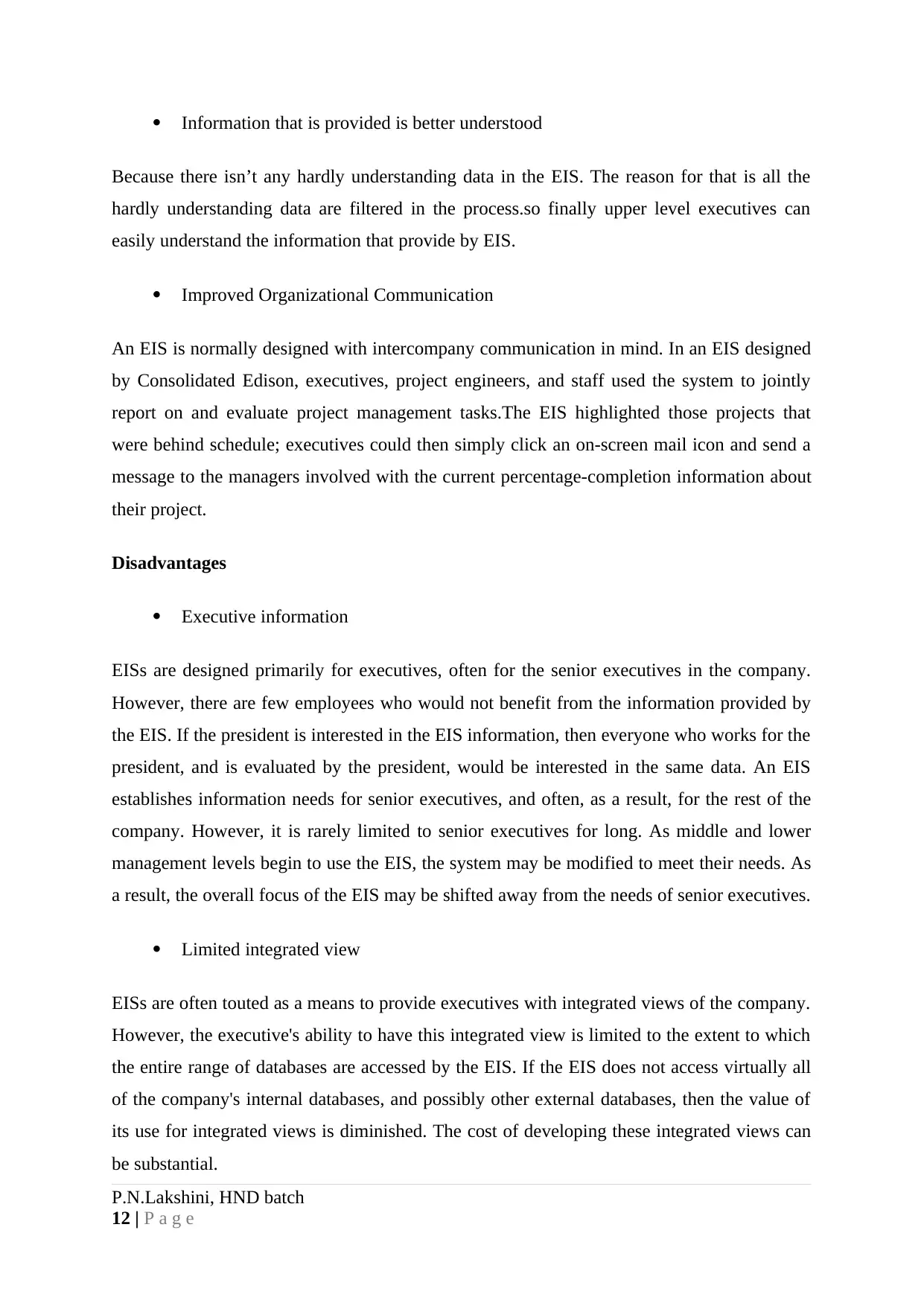
Information that is provided is better understood
Because there isn’t any hardly understanding data in the EIS. The reason for that is all the
hardly understanding data are filtered in the process.so finally upper level executives can
easily understand the information that provide by EIS.
Improved Organizational Communication
An EIS is normally designed with intercompany communication in mind. In an EIS designed
by Consolidated Edison, executives, project engineers, and staff used the system to jointly
report on and evaluate project management tasks.The EIS highlighted those projects that
were behind schedule; executives could then simply click an on-screen mail icon and send a
message to the managers involved with the current percentage-completion information about
their project.
Disadvantages
Executive information
EISs are designed primarily for executives, often for the senior executives in the company.
However, there are few employees who would not benefit from the information provided by
the EIS. If the president is interested in the EIS information, then everyone who works for the
president, and is evaluated by the president, would be interested in the same data. An EIS
establishes information needs for senior executives, and often, as a result, for the rest of the
company. However, it is rarely limited to senior executives for long. As middle and lower
management levels begin to use the EIS, the system may be modified to meet their needs. As
a result, the overall focus of the EIS may be shifted away from the needs of senior executives.
Limited integrated view
EISs are often touted as a means to provide executives with integrated views of the company.
However, the executive's ability to have this integrated view is limited to the extent to which
the entire range of databases are accessed by the EIS. If the EIS does not access virtually all
of the company's internal databases, and possibly other external databases, then the value of
its use for integrated views is diminished. The cost of developing these integrated views can
be substantial.
P.N.Lakshini, HND batch
12 | P a g e
Because there isn’t any hardly understanding data in the EIS. The reason for that is all the
hardly understanding data are filtered in the process.so finally upper level executives can
easily understand the information that provide by EIS.
Improved Organizational Communication
An EIS is normally designed with intercompany communication in mind. In an EIS designed
by Consolidated Edison, executives, project engineers, and staff used the system to jointly
report on and evaluate project management tasks.The EIS highlighted those projects that
were behind schedule; executives could then simply click an on-screen mail icon and send a
message to the managers involved with the current percentage-completion information about
their project.
Disadvantages
Executive information
EISs are designed primarily for executives, often for the senior executives in the company.
However, there are few employees who would not benefit from the information provided by
the EIS. If the president is interested in the EIS information, then everyone who works for the
president, and is evaluated by the president, would be interested in the same data. An EIS
establishes information needs for senior executives, and often, as a result, for the rest of the
company. However, it is rarely limited to senior executives for long. As middle and lower
management levels begin to use the EIS, the system may be modified to meet their needs. As
a result, the overall focus of the EIS may be shifted away from the needs of senior executives.
Limited integrated view
EISs are often touted as a means to provide executives with integrated views of the company.
However, the executive's ability to have this integrated view is limited to the extent to which
the entire range of databases are accessed by the EIS. If the EIS does not access virtually all
of the company's internal databases, and possibly other external databases, then the value of
its use for integrated views is diminished. The cost of developing these integrated views can
be substantial.
P.N.Lakshini, HND batch
12 | P a g e
⊘ This is a preview!⊘
Do you want full access?
Subscribe today to unlock all pages.

Trusted by 1+ million students worldwide
1 out of 23
Related Documents
Your All-in-One AI-Powered Toolkit for Academic Success.
+13062052269
info@desklib.com
Available 24*7 on WhatsApp / Email
![[object Object]](/_next/static/media/star-bottom.7253800d.svg)
Unlock your academic potential
Copyright © 2020–2025 A2Z Services. All Rights Reserved. Developed and managed by ZUCOL.




